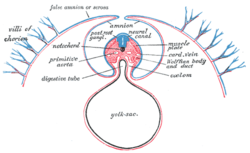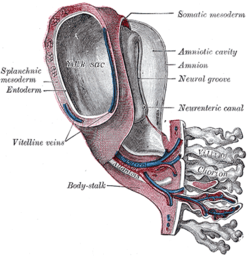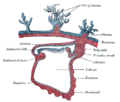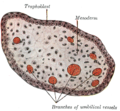- Chorionic villi
-
Chorionic villi Diagram of a transverse section, showing the mode of formation of the amnion in the chick. The amniotic folds have nearly united in the middle line. Ectoderm, blue; mesoderm, red; entoderm and notochord, black. (Villi of chorion labeled at upper left.) Model of human embryo 1.3 mm. long. (Villi of chorion labeled at lower right.) Gray's subject #12 60 Days 24 MeSH Chorionic+Villi Chorionic villi are villi that sprout from the chorion in order to give a maximum area of contact with the maternal blood.
Embryonic blood is carried to the villi by the branches of the umbilical arteries, and after circulating through the capillaries of the villi, is returned to the embryo by the umbilical veins.
Thus, the villi are part of the border between maternal and fetal blood during pregnancy.
In 1983 an italian biologist named Giuseppe Simoni discovered a new method of prenatal diagnosis using chorionic villi.
Contents
Development
The chorion undergoes rapid proliferation and forms numerous processes, the chorionic villi, which invade and destroy the uterine decidua and at the same time absorb from it nutritive materials for the growth of the embryo.
They undergo several stages, depending on their composition.
Stage Description Period of gestation Contents Primary The chorionic villi are at first small and non-vascular. End of 4th week trophoblast only [1] Secondary The villi increase in size and ramify, while the mesoderm grows into them. 5th week trophoblast and mesoderm[1] Tertiary Branches of the umbilical vessels grow into the mesoderm, and in this way the chorionic villi are vascularized. 5th - 6th week trophoblast, mesoderm, and blood vessels [1] Until about the end of the second month of pregnancy the villi cover the entire chorion, and are almost uniform in size, but after this they develop unequally.
Relations
The villi can also be classified by their relations:
Floating villi
These villi are found floating freely in the intervillous space. They exhibit a bi-layered epithelium consisting of cytotrophoblasts with overlaying syncytium (syncytiotrophoblast).
Anchoring (stem) villi
These villi act to stabilise mechanical integrity of the placental-maternal interface.
Tissue composition and cell types
The bulk of the villi consist of connective tissues in which blood vessels are found. Most of the cells in the connective tissue core of the villi are fibroblasts. Macrophages known as Hofbauer cells are also present.
Additional images
Stem cell
Chorionic villi are rich of stem cells: Biocell Center, a biotech company managed by Giuseppe Simoni and based also in Medford, MA, is studying and testing these types of stem cells. Chorionic stem cells, like amniotic stem cells, are multipotent stem cells without any ethical problem and now it's possible to criopreserve amniotic stem cell for autologous use [2][3][4].
See also
- Chorionic villus sampling
- Villitis of unknown etiology
References
- ^ a b c Larsen, William J. : Human embryology. Sherman, Lawrence S.; Potter, S. Steven; Scott, William J. 3. ed.
- ^ "European Biotech Company Biocell Center Opens First U.S. Facility for Preservation of Amniotic Stem Cells in Medford, Massachusetts | Reuters". 2009-10-22. http://www.reuters.com/article/pressRelease/idUS166682+22-Oct-2009+PRN20091022. Retrieved 2010-01-11.
- ^ "Europe's Biocell Center opens Medford office - Daily Business Update - The Boston Globe". 2009-10-22. http://www.boston.com/business/ticker/2009/10/europes_biocell.html. Retrieved 2010-01-11.
- ^ "The Ticker - BostonHerald.com". http://www.bostonherald.com/business/general/view/20091022the_ticker. Retrieved 2010-01-11.
External links
This article was originally based on an entry from a public domain edition of Gray's Anatomy. As such, some of the information contained within it may be outdated.
Embryonic adnexa Trophoblast (Cytotrophoblast, Syncytiotrophoblast, Intermediate trophoblast)
Chorionic villi/Intervillous space · Amnion/Amniotic sac/Amniotic cavity
rostral embryonic ligament · caudal embryonic ligamentFetal membranes Circulatory Ungrouped Categories:- Embryology
- Developmental biology stubs
Wikimedia Foundation. 2010.







